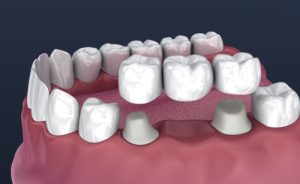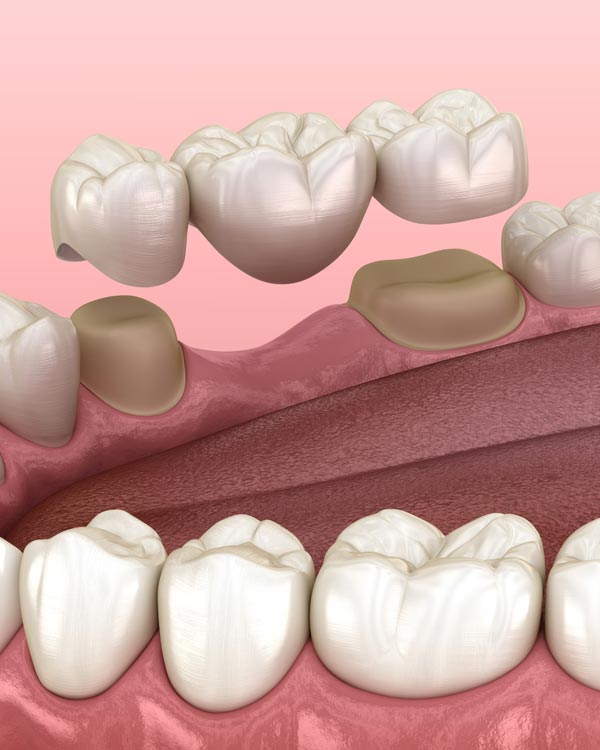Revitalize Your Smile with Traditional Dental Bridges in Vero Beach, FL

To learn more about the benefits of traditional dental bridges, don’t hesitate to contact our Vero Beach dental office by calling (772) 770-2225.
What Are Traditional Dental Bridges?
A traditional dental bridge is a prosthetic device that consists of one or more artificial teeth (pontics) that are anchored to adjacent teeth (abutment teeth) using dental crowns. The dental crowns are placed over the abutment teeth, serving as anchors for the bridge. The pontics are custom-made to match the color and shape of your natural teeth and are attached to the crowns to fill the gap created by the missing tooth/teeth.
A cantilever bridge is another type of dental bridge that is used when there are adjacent teeth on only one side of the missing tooth or teeth. It consists of a pontic anchored to a single abutment tooth with a dental crown. This type of bridge is typically used in areas of the mouth that are under less stress, such as the front teeth. The procedure for a cantilever bridge usually requires fewer visits and can be more cost-effective, but it may not be as strong as traditional bridges and can place additional stress on the single anchor tooth.
Maryland bridges, also known as resin-bonded bridges, use a metal or porcelain framework with resin wings that are bonded to the back of adjacent teeth. This type of bridge is a more conservative option as it requires minimal alteration to the adjacent teeth. Maryland bridges are ideal for patients with healthy teeth on either side of the gap. However, they may not be as durable as traditional bridges and can sometimes become dislodged.
Benefits of Traditional Dental Bridges

- Restored Chewing Functionality: Dental bridges help restore the ability to chew and eat properly. When teeth are missing, it can become difficult to chew certain foods, leading to nutritional deficiencies and digestive issues. Bridges provide a stable and functional chewing surface, allowing individuals to enjoy a varied diet without restrictions.
- Improved Speech: Missing teeth can affect speech, causing difficulties in pronouncing certain words and sounds. Dental bridges fill the gaps and prevent speech impediments that might arise due to missing teeth.
- Maintains Facial Structure: Teeth play a crucial role in maintaining the natural shape and structure of the face. When teeth are lost, the surrounding tissues can start to sag, giving a sunken appearance. Bridges help support the facial structure and prevent such changes.
- Aesthetics and Confidence: Dental bridges are designed to match the appearance of your natural teeth. They are customized to blend seamlessly with your existing teeth, enhancing your smile and boosting your confidence.
- Prevents Teeth Shifting: Gaps left by missing teeth can lead to adjacent teeth shifting out of their proper positions. This can result in bite problems and misalignment. Dental bridges fill these gaps, preventing unwanted tooth movement.
- Simple Procedure: Getting a traditional dental bridge is a relatively straightforward procedure that typically requires only a few dental visits. It involves preparing the adjacent teeth (abutment teeth) to support the bridge and then placing the bridge itself.
- Durable and Long-Lasting: When properly cared for, dental bridges can last for many years. They are made from durable materials that can withstand the forces of regular chewing.
- Cost-Effective: Compared to some other tooth replacement options, such as dental implants, traditional bridges are generally more cost-effective. This makes them a viable option for individuals with budget constraints.
- Non-Invasive: Dental bridges do not require surgical procedures like dental implants. The process involves shaping the adjacent teeth to support the bridge, but it’s generally less invasive than implant surgery.
- Quick Results: In comparison to some alternatives that might require longer treatment periods, dental bridges can provide a quicker solution for restoring missing teeth and improving oral health.
- Implant-Supported Bridges: For patients with multiple missing teeth, implant-supported bridges offer a robust solution. These bridges do not rely on adjacent teeth and can span large gaps, providing stability and preventing complications such as misaligned bite and strain on the jaw joint. The placement procedure involves dental implants, which support the bridge, ensuring a durable and long-lasting result.
Who’s a Candidate for Traditional Dental Bridges?
You may qualify for this tooth replacement option if you have:
- Healthy Adjacent Teeth: Traditional dental bridges require healthy teeth adjacent to the gap to anchor the pontic(s) with dental crowns. If the adjacent teeth have decay or gum disease, they may not be strong enough to support the bridge.
- Sufficient Bone Density: Adequate bone density in the jaw is necessary to support the dental crowns that anchor the bridge. If you have experienced bone loss due to gum disease or other conditions, a dental bridge may not be a viable option.
- Good Oral Hygiene Habits: Good oral hygiene is crucial to the success of a dental bridge. Patients must commit to maintaining excellent brushing, flossing, and regular dental check-ups to keep their remaining teeth and gums healthy.
- Good General Health: Patients with certain health conditions, such as diabetes or autoimmune disorders, may be at higher risk for complications with dental bridge procedures. Your Vero Beach dentist will consider your overall health status before recommending a dental bridge.
- Aesthetics Goals: Traditional dental bridges can be customized to match the color and shape of your natural teeth, making them an excellent option for restoring your smile’s aesthetics. If you’re looking for a natural-looking solution to replace missing teeth, a dental bridge may be a suitable option.
- Financial Considerations: Traditional dental bridges are often a more affordable option than other tooth replacement options, such as dental implants. If cost is a significant consideration for you, a dental bridge may be the right choice.
- Alternative Options: Patients who do not qualify for traditional dental bridges due to insufficient bone density or other factors might consider an implant-supported bridge as an alternative. Implant-supported bridges are similar to regular dental bridges but are supported by dental implants instead of natural teeth, offering a stable and durable solution for multiple missing teeth.
Traditional Dental Bridge Costs
The cost of traditional dental bridges can vary based on several factors. These factors include the number of teeth being replaced, the materials used for the bridge, the complexity of the case, the location of the dental practice, and any additional procedures that might be necessary, such as tooth extractions or gum treatments.
Frequently Asked Questions
The lifespan of a traditional dental bridge can vary based on factors like oral hygiene, wear and tear, and the materials used. With proper care and regular dental check-ups, bridges can often last between 5 to 15 years or even longer. Good oral hygiene practices and avoiding excessive forces on the bridge, such as biting on hard objects, can extend its longevity.
After getting a dental bridge, it’s important to be mindful of your diet. While bridges restore chewing function, it’s advisable to avoid extremely hard or sticky foods that could potentially damage the bridge or dislodge it. Maintaining a balanced diet that’s gentle on your teeth will help preserve the integrity of the bridge.
Not everyone is a candidate for a traditional dental bridge. Suitable candidates typically have healthy abutment teeth with enough structural integrity to support the bridge. Additionally, good oral health is important to ensure the longevity of the bridge. If a patient has certain dental or medical conditions, alternatives like dental implants or partial dentures might be recommended.
Complete Your Smile With Traditional Bridges at Vero Beach Dental Care
Traditional dental bridges at Vero Beach Dental Care offer a reliable and natural-looking solution for those with missing teeth. Our commitment to patient satisfaction and oral health drives us to provide comprehensive care and top-quality restorative treatments. Whether you’re seeking to regain your smile’s functionality or enhance its aesthetics, our skilled team is dedicated to helping you achieve a healthy, confident smile that lasts.
Schedule a consultation at Vero Beach Dental Care by calling our Vero Beach, FL dental practice at (772) 770-2225. Experience the difference with our traditional dental bridges and take the first step towards revitalizing your smile today.

